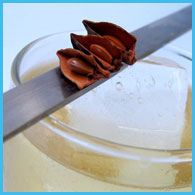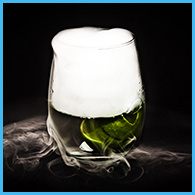Cocktail Chill – A Scientific Experiment
“I’d like a Martinez, heavy on the vermouth, warmed in the microwave for 23 seconds.”
What’s the difference between a chilled cocktail and an Arctic-cold cocktail? One word: perfection. The colder you can get a drink and the longer you can keep it cold, the better.
I could make this article a treatise on the importance of ice, but you probably wouldn’t be reading this if you didn’t understand its vast importance in the crafting of a cocktail. What I do want to do is take you from a cold cocktail to a cocktail that refreshes, bites, and makes you want to put on a coat. If by the end of this experiment, I have created a method that makes a wonderful drink that’s 3°F colder, I will feel that I have succeeded. I will be using the Fancy Gin Cocktail throughout this test, as it is a fine concoction and benefits greatly from chilly temperatures
Fancy Gin Cocktail
- 2 dashes simple syrup
- 1 dashes Angostura bitters
- 1 dashes orange curacao
- 2oz gin
- lemon twist
Stir (or shake) with ice, and strain into a chilled cocktail glass. Twist the lemon peel to release its oil, and drop it in.
From: The Craft of the Cocktail, Dale Degroff
Constants
- Ice: Refrigerator icemaker generated half moons, 1 1/2″ long, at about -8°F.
- Boston Shaker: 28oz metal cup, 16oz mixing glass.
- Chilled cocktail glass: 7 1/2oz
- Spirits: Gordon’s London dry gin, Marie Brizard orange curacao
- All spirits and utensils started at room temperature: 65° F.
- Ice: 15 cubes (filling the mixing glass a little over half way)
Experiments
Stirred for 30 seconds | 27° F | Chilly, but not as much as I’d like. The water content could be increased ever so slightly.
Stirred for 1 minute | 24° F | Now we are getting somewhere; those 3° really made a difference in the bite of the cocktail, and the amount of water was nearly perfect.
Stirred for 30 seconds with cracked ice | 24° F | The final result of this method is nearly identical to the previous.
Stirred for 60 seconds with cracked ice | 21° F | Some would consider the water content to be a touch high, but I think the extra chill may make up for it.
Stirred for 30 seconds with crushed ice | 17° F | Wow. You can tell that the viscoity of the drink has changed; it’s a bit thicker than before. If my old scotch knowledge is still in tact, this fact is confirmed by the drink’s legs. Surprisingly, even with the use of crushed ice, the water content is a little low. The coldness nearly makes up for this, but I think a touch more water would make this perfect.
Stirred for 60 seconds with crushed ice | 17° F | The 30 extra seconds did nothing for the water content. The ice just must be too cold to melt any more.
Conclusions
I was able to drop the temperature 10° from my initial method with the only difference being the use of crushed ice instead of full-moon ice. I’m guessing the biggest factor in me being able to get my drinks this cold is that the ice starts at -8° F. I cannot back this up with evidence, but my freezer does go up to 7° F, so perhaps I will redo the test at some point with the higher temperature. My only suggestion for getting your ice colder is to stick it outside if you live in a frigid climate.
I wasn’t 100% happy with the final water content of the 17° cocktail, but it was the best, by far.
Future tests will include shaking as a method, and hopefully a new cocktail. And if you’re wondering, I did this test over the course of a couple of weeks, as it included many tests that I did not post, in addition to what you see above.
5 Responses to “Cocktail Chill – A Scientific Experiment”
You can leave a response, or trackback from your own site.



Interesting! and good info. You should add the shaken tests too – I thought that was the strangest (and most interesting) result.
I’d make the argument that there’s a temperature below which a drink is too cold – it’s just hard to reach that point. You could *maybe* get closer using the jet freezer to yield ice that’s at -20 degrees? At some point it’s going to have to taste less good, or be painfully cold, or both. Liquid Nitrogen Cocktail!
I definitely agree. Getting the right amount of melted ice in the drink was really key in this experiment. I would like to try the 17° method with a few other cocktails (e.g. martini, rob roy) too, as I wouldn’t want to prescribe it as “the method” for everything.
That was cool.You seem to have an incredible amount of knowledge on cocktails.And you have chosen to impart your knowledge to others. That was very nice of you…
“I’d like a Martinez, heavy on the vermouth, warmed in the microwave for 23 seconds.”
Warmed in the microwave?? this is the first time that I’ve heard about it. Your experiment seems interesting. I’ll try it out later.
Katie Smith
My Blog: http://www.allcelebritygossip.com/Kim Kardashian Video /